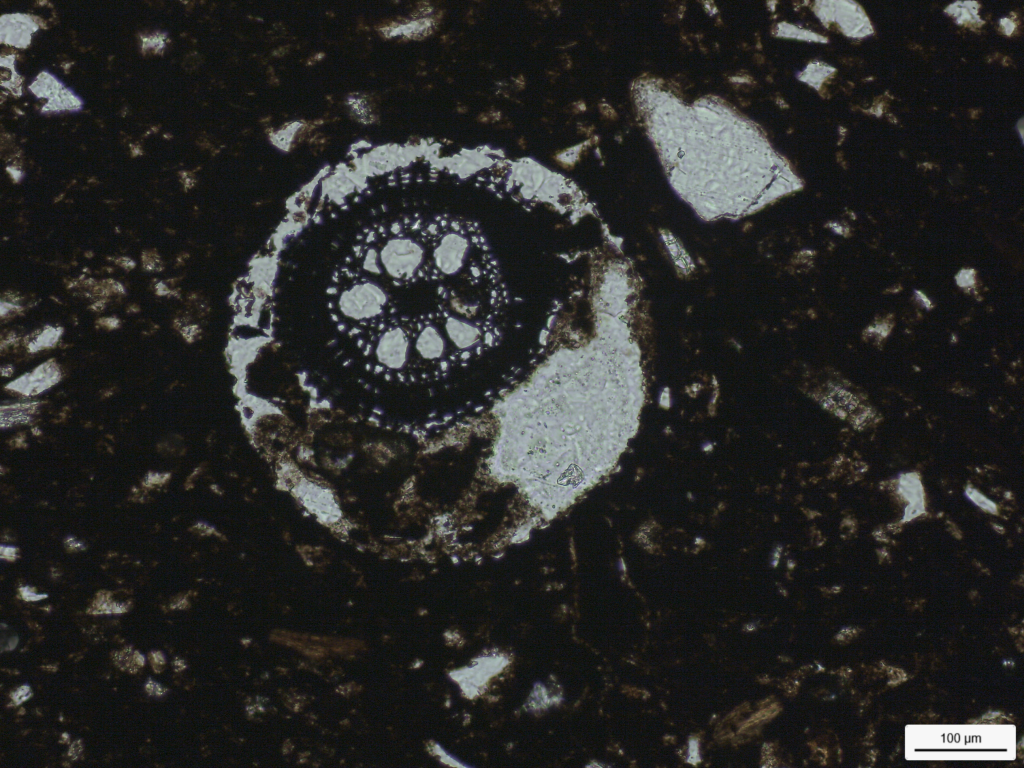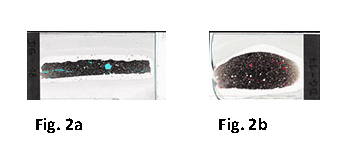In the last few weeks I haven’t been very present in our blog since I spent much time sitting at the microscope of the Department of Earth and Environmental Sciences of the LMU, just nearby to our office, examining and documenting the first batch of ceramic samples from the site of Dukki Gel. These samples have been included as a reference collection within our DiverseNile project thanks to the kind agreement of the excavator, Charles Bonnet, and the responsible ceramicist Philippe Ruffieux. Philippe has already studied all of these samples within their context and we can now address fresh questions within the DiverseNile work packages and with scientific analysis.
In times of the Covid pandemic, the procedure to access the laboratories is rightly strict: registration is mandatory before working in the microscopy room, only a maximum of three people are allowed to work simultaneously in the lab and of course we are required to wear medical masks and disinfect all devices and workspace at the end. All this will seem obvious, but what I personally find curious is the contrast between the meticulousness of the analytical procedure, further complicated by the current Covid rules, and the simple and tangible nature of the ancient ceramics, whose immense anthropological and material complexity, and huge archaeological interpretative potential is all enclosed in a thin section of just 30 microns thick.
In my last blog post – I introduced the method I use for the classification of the ceramic samples and the layout within the Filemaker database which I specifically designed for the purpose of the petrographic study.
So far a total of twenty-one ceramic samples from Dukki Gel has been analysed by optical microscopy (OM), while forty-three samples are currently located at the Atominstitute in Vienna where they are being analysed for instrumental Neutron Activation Analysis (iNAA) by our colleague and external expert in the project Johannes Sterba.
Most of the samples for OM (18 out of 21) are Nubian vessels among which are cooking pots (both basketry impressed and incised ware), jars, globular vessels and also fine black topped Kerma ware. Further, three Egyptian-type vessels (two red slipped bowls and one fragment of a bread mould) were analysed under the microscope.
Petrographically, the Nubian samples from Dukki Gel appear quite homogeneous in term of their composition, displaying mineralogical and textural features which also resemble very much the petrography of the Nubian samples analysed from the New Kingdom town of Sai Island (see D’Ercole and Sterba 2018; D’Ercole in prep.). Differences in the textural features, in the proportion of some specific mineral phases, and in the amount and type of the organic tempers contained in the paste allowed distinguishing four principal petrographic groups or micro fabrics. The first group is characterized by a very sandy framework with a dominant grain size in the class of silt to very fine-grained sand, a good sorting of the non-plastics and very few organics mainly small and tubular in shape. The second group also displays a sandy framework, sorting is moderate with some medium sized rounded quartz and feldspar possibly added as temper, and common tubular organics partially carbonized and moderately aligned. Group 3, to which belongs the majority of the analysed samples, is sandy, moderately sorted, with common to abundant organics, either partially or completely carbonized, heterogeneous in shape and size, and possibly referring to various parts of plant remains (including stem, glume, palea, and lemma?) (Fig. 1) and also herbivore dung. Finally, the fourth group of Dukki Gel Nubian samples contains abundant heterogeneous organics similar to group 3 but also large carbonate inclusions of microcrystalline calcite most likely intentionally added as tempering material. To this last group, which does not show a real comparison with the material from Sai, where the presence of calcite was ubiquitous and seemed a natural component in the clay source/ soil rather than a tempering agent, refers exclusively cooking pots with basketry impressions and a single jar.

All in all, similarly to what was observed for Sai Island, the petrofacies of the Nubian ceramics is very homogeneous and points to the selection of clays, or better soils, derived from local Holocene Nile alluvia, with a composition very similar along the various sectors of the Nile river (D’Ercole and Sterba 2018). These ceramics were possibly tempered with some medium- and coarse-sized aeolian sand or with quartz grains drained by the local river systems. Technologically, the amount and type of the organic material added to the paste (more or less abundant and selected) makes the main difference and allows distinguishing among various sub-recipes or ways of doing the vessels. Further, the orientation of the voids left by the combustion of the organic matter into the paste permits to recognize among the use of different manufacturing techniques. Specifically, in the cooking pots with basketry impressions which were built on a mat, the organics appear generally well or moderately aligned with a prevalent presence of longitudinal features like stems or plant stalks (Fig. 2a). Differently, in those pots (e.g., globular pots, bowls) built with the coiling technique, the organics show mainly a poor alignment and a specific orientation that indicates the ‘relict’ coil features (Fig. 2b). The black topped and the fine polished Kerma ware generally contain less organics, these latter are also smaller in size indicating either the use of herbivore dung and/or a selection of added plant remains.

Figure 2b – Thin section scan of Sample DG-17 (Nubian large bowl). The specific concentric alignment of the pores structures and of the voids and relicts left by the combustion of the organics indicates that this vessel was manufactured with the coiling technique. Image by G. D’Ercole.
Highly interesting in the sample from Dukki Gel, is the presence of a jar with a roughly polished / wet-smoothed black surface which although showing clear Nubian technological exterior features is characterized by a coarser and sandier fabric with more abundant feldspar and granitoid rock fragments resembling certain Egyptian cooking pots (Fig. 3). This sample, so far an unicum in our selection, points to an hybridization of Nubian and Egyptian traditions (this time with the intersection of some performance of ‘Egyptian’ criteria to a general Nubian technological and stylistical formula) and well supports our overall theoretical framework and working approach on the complexity and diversity among various Nubian local narrative experiences and conceptions of material culture.

Hopefully by the end of this month, we also will have the first set of chemical data from the reference collection from Dukki Gel in our hands which we will then compare with the macroscopic evidence and with these petrographic remarks.
References
D’Ercole, G. In prep. Petrography of the pottery from the New Kingdom town of Sai, in: J. Budka, with contributions by G. D’Ercole, J. Sterba and P. Ruffieux, AcrossBorders 3: Vessels for the home away from Egypt. The pottery corpus from the New Kingdom town of Sai Island. Archaeology of Egypt, Sudan and the Levant. Vienna.
D’Ercole, G. and Sterba, J. H. 2018. From macro wares to micro fabrics and INAA compositional groups: the Pottery Corpus of the New Kingdom town on Sai Island (northern Sudan), 171–183, in: J. Budka and J. Auenmüller (eds.), From Microcosm to Macrocosm: Individual households and cities in Ancient Egypt and Nubia. Leiden.
